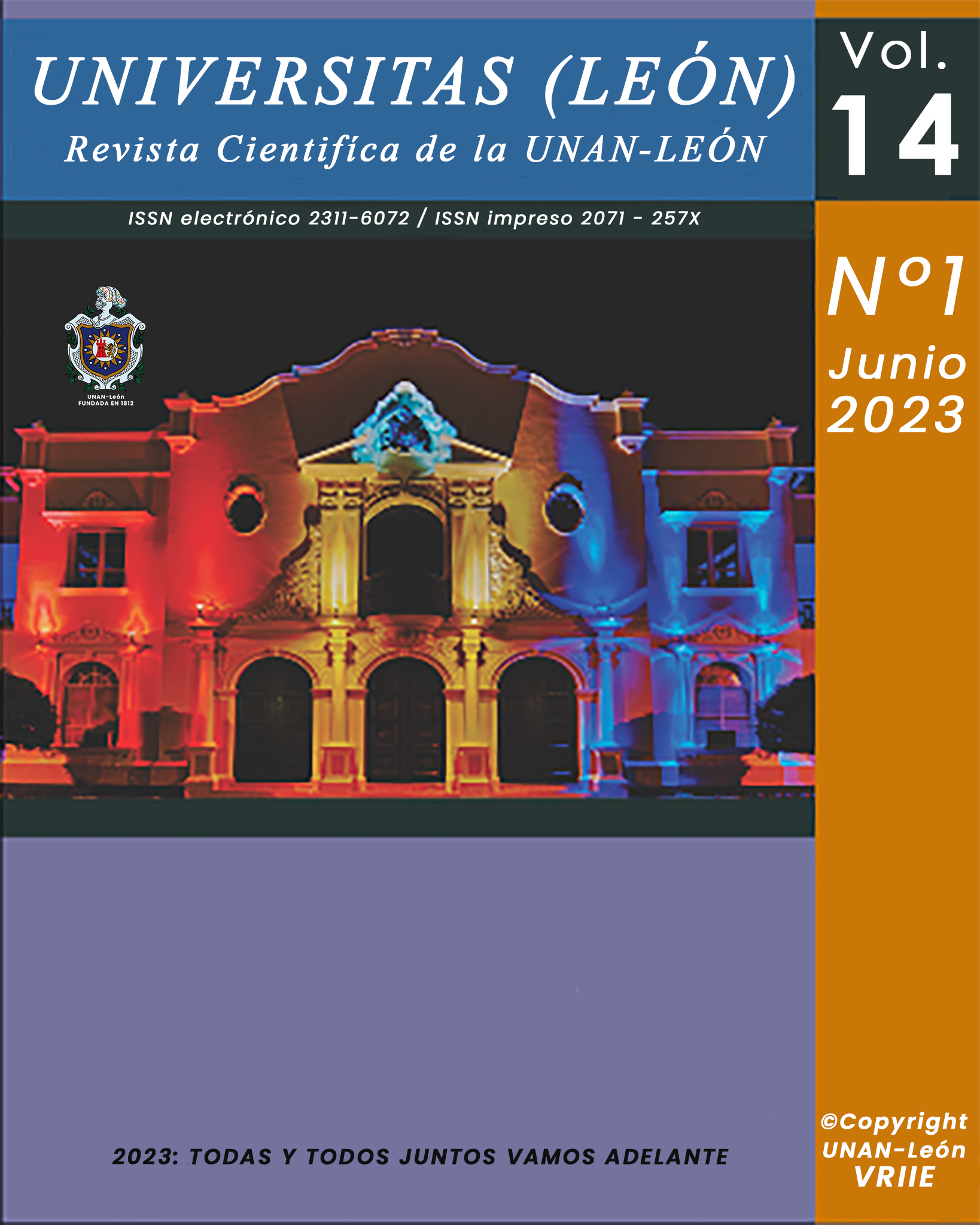Intrapartum prophylaxis in the reduction of neonatal sepsis with maternal risk factors for group B Streptococcus, in León Nicaragua.
DOI:
https://doi.org/10.5377/universitas.v14i1.16470Keywords:
Pregnancy, group B streptococci (GBS), early neonatal sepsis, late neonatal sepsis, intrapartum prophylaxis (IAP).Abstract
Colonization or infection by group B (GBS) are important causes of neonatal sepsis and meningitis worldwide. (Gonzalez, 2022) . In order to know the effect of intrapartum prophylaxis in the reduction of neonatal sepsis with maternal risk factors for group B Streptococci, in León Nicaragua, an analytical study of cases and controls of deliveries attended in a public hospital in Nicaragua was carried out, taking as an axis whether or not they received intrapartum prophylaxis. A sample of 202 records of the mother-son binomial was determined, finding that the implementation of PAI in the pregnant woman offers 90% protection; the protective factor of PAI in prolonged RPM membrane rupture 91.5% (OR 0.85, (95% CI: 0.34-0.26) with a value of p=0.000). The non-use of PAI leads to the development of early neonatal sepsis with an OR 8.952 (95%CI 3.492-22.947) p=0.000; for cases of late neonatal sepsis OR 4.634 (95% CI 1.190-18.042) p=0.027.Neonatal screening and intrapartum prophylaxis based on maternal risk factors for GBS is an effective strategy in reducing the development of neonatal sepsis in Nicaragua.
Downloads
References
Alemán, T., Vielot, N. A., Herrera, R., Velasquez, R., Berrios, T., Toval-Ruíz, C., Téllez, E., Herrera, A., Aguilar, S., & Becker-Dreps, S. (2022a). Rectovaginal Colonization with Serotypes of Group B Streptococci with Reduced Penicillin Susceptibility among Pregnant Women in León, Nicaragua. Pathogens, 11(4), 415. https://doi.org/10.3390/pathogens11040415
Arosemena Viteri, E. M. (2019). Factores relacionados con sepsis neonatal en prematuros en la Unidad de Cuidados Intensivos.
Arreaga, L. D. P. T., Avilés, D. A. R., Rivera, M. K. B., & Caballero, J. V. C. (2019). Factores de riesgo y prevención de sepsis neonatal temprana. RECIMUNDO, 3(3 ESP), 513-528.
Berardi, A., Rossi, C., Creti, R., China, M., Gherardi, G., Venturelli, C., Rumpianesi, F., & Ferrari, F. (2013). Group B streptococcal colonization in 160 mother-baby pairs: A prospective cohort study. The Journal of pediatrics, 163(4), 1099-1104. https://doi.org/10.1016/j.jpeds.2013.05.064
Berrios Téllez, T. V. (2022). Prevalencia de colonización recto-vaginal de serotipos antibiótico-resistentes de Streptococcus agalactiae del grupo B en mujeres embarazadas con>= 35 semanas del sector salud Mantica Berio. del Fresno Serrano, M. Á., Cabezas, L. B., &
Rodríguez, C. M. (2022). Profilaxis del estreptococo grupo B intraparto. Revista Sanitaria de Investigación, 3(1), 85.
Delgado-Arévalo, K. J., González-Habib, R., Castro-Torres, I., Bennett-Vidales, G., & Cruz-de la Cruz, C. de la. (2020). Tamizaje del estreptococo del grupo B durante el embarazo: Conducta actual en un centro de tercer nivel. Ginecología y obstetricia de México, 88(2), 127-129.
Doenhardt, M., Seipolt, B., Mense, L., Winkler, J. L., Thürmer, A., Rüdiger, M., Berner, R., & Armann, J. (2020). Neonatal and young infant sepsis by Group B Streptococci and Escherichia coli: A single-center retrospective analysis in Germany-GBS screening implementation gaps and reduction in antibiotic resistance. European Journal of Pediatrics, 179(11), 1769-1777. https://doi.org/10.1007/s00431-020-03659-8 https://doi.org/10.1007/s00431-020-03659-8
Flores Navarro-Pérez, C., González-Jiménez, E., Schmidt-RioValle, J., Meneses-Echávez, J. F., Martínez-Torres, J., & Ramírez-Vélez, R. (2015). Factores sociodemográficos y seguimiento prenatal asociados a la mortalidad perinatal en gestantes de Colombia. Nutrición hospitalaria, 32(3), 1091-1098.
Garland, S. M. (1991). Early onset neonatal group B streptococcus (GBS) infection: Associated obstetric risk factors. Australian and New Zealand journal of obstetrics and gynaecology, 31(2), 117-118. https://doi.org/10.1111/j.1479-828X.1991.tb01796.x
Gonzalez, A. C. (2022). Infecciones por Estreptococcus beta hemolítico del grupo B en recién nacidos.
Hayes, K., O'Halloran, F., & Cotter, L. (2020). A review of antibiotic resistance in Group B Streptococcus: The story so far. Critical reviews in microbiology, 46(3), 253-269. https://doi.org/10.1080/1040841X.2020.1758626
Lin, F.-Y. C., Weisman, L. E., Troendle, J., & Adams, K. (2003). Prematurity is the major risk factor for late-onset group B streptococcus disease. The Journal of infectious diseases, 188(2), 267-271. https://doi.org/10.1086/376457
Lu, B., Li, D., Cui, Y., Sui, W., Huang, L., & Lu, X. (2014). Epidemiology of Group B streptococcus isolated from pregnant women in Beijing, China. Clinical Microbiology and Infection, 20(6), O370-O373. https://doi.org/10.1111/1469-0691.12416
Mengist, H. M., Zewdie, O., Belew, A., & Dabsu, R. (2017). Prevalence and drug susceptibility pattern of group B Streptococci (GBS) among pregnant women attending antenatal care (ANC) in Nekemte Referral Hospital (NRH), Nekemte, Ethiopia. BMC research notes, 10, 1-6. https://doi.org/10.1186/s13104-017-2725-3
Raya Piña, M. G., & Esteban Méndez, H. C. (2013). Prevalencia de Estreptococo del Grupo B en mujeres embarazadas en el Hospital General de Tlalnepantla del 1 de diciembre del 2012 al 31 de enero del 2013.
Tsai, M.-H., Hsu, J.-F., Lai, M.-Y., Lin, L.-C., Chu, S.-M., Huang, H.-R., Chiang, M.-C., Fu, R.-H., & Lu, J.-J. (2019). Molecular characteristics and antimicrobial resistance of group B Streptococcus strains causing invasive disease in neonates and adults. Frontiers in microbiology, 10, 264. https://doi.org/10.3389/fmicb.2019.00264
Vieira, L. L., Perez, A. V., Machado, M. M., Kayser, M. L., Vettori, D. V., Alegretti, A. P., Ferreira, C. F., Vettorazzi, J., & Valério, E. G. (2019). Group B Streptococcus detection in pregnant women: Comparison of qPCR assay, culture, and the Xpert GBS rapid test. BMC pregnancy and childbirth, 19(1), 1-8. https://doi.org/10.1186/s12884-019-2681-0
Vielot, N. A., Toval-Ruíz, C. E., Weber, R. P., Becker-Dreps, S., & Alemán Rivera, T. de J. (2021). Rectovaginal group B streptococcus colonization among pregnant women in Nicaragua: A systematic review and meta-analysis. The Journal of Maternal-Fetal & Neonatal Medicine, 34(15), 2418-2426. https://doi.org/10.1080/14767058.2019.1667324
Yi, A., Kim, C.-K., Kimura, K., Arakawa, Y., Hur, M., Yun, Y.-M., & Moon, H.-W. (2019). First case in Korea of group B Streptococcus with reduced penicillin susceptibility harboring amino acid substitutions in penicillin-binding protein 2X. Annals of Laboratory Medicine, 39(4), 414. https://doi.org/10.3343/alm.2019.39.4.414
Downloads
Published
How to Cite
Issue
Section
License
Copyright (c) 2023 National Autonomous University of Nicaragua

This work is licensed under a Creative Commons Attribution-NonCommercial-ShareAlike 4.0 International License.
Copyright © 2025 Universitas (León), Revista Cientifíca de la UNAN-León. Academic Direction. Research Department. Publication and Scientific Event Unit.










